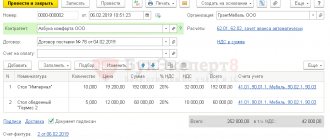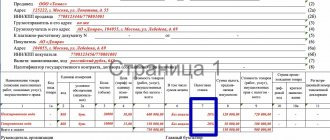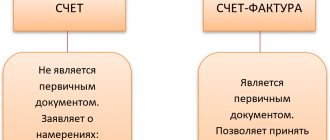Upper part of the Invoice (header)
- Number and Date . The number must correspond to the numbering of documents approved in the accounting policy of your organization. The date indicated is current at the time of creation of the Invoice.
- Correction and Date . The correction number must correspond to the document numbering approved in the accounting policies of your organization. The date indicated is current at the time the Invoice is corrected. When drawing up an Invoice, before making corrections to it, a dash is placed in this line.
- Column Seller , the full and abbreviated name of the legal entity or individual entrepreneur (seller) is indicated.
- Column Address , the full address (with index) of a legal or individual entrepreneur (seller) is indicated.
- The seller's TIN/KPP column indicates the TIN and KPP of the legal entity (seller). An individual entrepreneur indicates only the TIN.
- The column Shipper and his address indicates the full and abbreviated name of the legal entity or individual entrepreneur (shipper), as well as his full address (with index). If the Invoice is drawn up for services performed (rendered) or property rights, then a dash is placed in this line.
- Column Consignee and his address , the full and abbreviated name of the legal entity or individual entrepreneur (consignee), as well as his full address (with index) is indicated. If the Invoice is drawn up for services performed (rendered) or property rights, then a dash is placed in this line.
- Column For payment and settlement document No. , indicates the number and date of the payment and settlement document (payment order) or cash receipt.
- Column Buyer , the full and abbreviated name of the legal entity or individual entrepreneur (buyer) is indicated.
- Column Address , the full address (with index) of a legal or individual entrepreneur (buyer) is indicated.
- The TIN/KPP column indicates the TIN and KPP of the legal entity (buyer). An individual entrepreneur indicates only the TIN.
- Column Currency: name, code , indicates the name of the currency and its code in accordance with the OKV classifier. The specified currency must be the same for all listed goods (works, services), property rights.
- Column Identifier of government contract, agreement (agreement) , indicates the identifier of the government contract, agreement or agreement. If there is no government order in the invoice, then a dash is added.
Invoice for services If the Invoice is drawn up for services performed (rendered) or property rights, then the two columns “ Consignor and his address ” and “ Consignee and his address ” are not filled in, you can put a dash (“–”) or a triple dash (“- — -“). If, when drawing up an invoice for services, you still fill in these two columns, then this will not be a mistake. In this case, this information will be additional information to the required details and cannot serve as a basis for refusing to deduct VAT.
Invoice
II. Rules for filling out an adjustment invoice used when calculating value added tax
1. The lines indicate:
a) in line 1 - the serial number and date of preparation of the adjustment invoice used in calculations of value added tax (hereinafter referred to as the adjustment invoice). The serial numbers of the adjustment invoice and invoice are assigned in general chronological order.
When the principal (principal) draws up an adjustment invoice issued to the commission agent (agent) selling goods (work, services), property rights on his own behalf, as well as when the commission agent (agent) draws up in this case an adjustment invoice issued to the buyer, the specified line indicates the date of issue of the adjustment invoice by the commission agent (agent) to the buyer.
When a commission agent (agent) who purchased goods (work, services), property rights on his own behalf draws up an adjustment invoice, the date from the adjustment invoice issued by the seller to the commission agent (agent) is transferred to this line. The serial numbers of such adjustment invoices are indicated by each taxpayer in accordance with their personal chronology of invoices.
If an organization has sold goods (work, services), property rights through separate divisions, when such separate divisions draw up adjustment invoices, the serial number of the adjustment invoice through a dividing line is supplemented by the organization-approved digital index of the separate division, established by the organization in the order on the accounting policy for tax purposes.
If the sale of goods (work, services), property rights was carried out by a participant in the partnership or a trustee acting as a taxpayer of value added tax, when this participant in the partnership or trustee draws up an adjustment invoice, the serial number of the adjustment invoice is separated by a dividing line supplemented by an approved participant in the partnership or trustee with a digital index indicating the completion of a transaction in accordance with a specific agreement of a simple partnership or trust management of property;
b) in line 1a - the serial number of the correction made to the adjustment invoice and the date of this correction. When drawing up an adjustment invoice, before making corrections to it, a dash is placed in this line;
c) in line 1b - the number and date of the invoice for which the adjustment invoice is drawn up, the number and date of correction of the invoice for which the adjustment invoice is drawn up. When indicating the number and date of the invoice (for which the adjustment invoice is drawn up) before making a correction in it, a dash is placed in this line instead of the correction number and instead of the date of correction;
d) in line 2 - the full or abbreviated name of the seller indicated in the invoice, to which the adjustment invoice is drawn up;
e) in line 2a - the location of the seller indicated in the invoice, to which the adjustment invoice is drawn up; By the way, the address can be abbreviated as “street.” "G." etc. (letter of the Ministry of Finance dated October 20, 2017 No. 03-07-14/68778).
f) in line 2b - taxpayer identification number and reason code for registering the taxpayer-seller, indicated in the invoice for which the adjustment invoice is drawn up;
g) in line 3 - the full or abbreviated name of the buyer indicated in the invoice, for which the adjustment invoice is drawn up;
h) in line 3a - the location of the buyer indicated in the invoice, to which the adjustment invoice is drawn up;
i) in line 3b - taxpayer identification number and reason code for registering the taxpayer-buyer, indicated in the invoice for which the adjustment invoice is drawn up;
j) in line 4 - the name of the currency and its digital code indicated in the invoice for which the adjustment invoice is drawn up.
You can automate the process using an online accounting tool like this one. 30 days there are free, you can generate documents during this time. Generate and report VAT via the Internet.
2. The columns indicate:
a) in column 1 - the name of the goods supplied (shipped) (description of work performed, services rendered), transferred property rights, which is indicated in column 1 of the invoice, to which an adjustment invoice is drawn up, for goods (work, services), property rights in respect of which the price (tariff) is changed and (or) the quantity (volume) is clarified;
b) in columns 2 and 2a in lines A (before the change) and (after the change) - unit of measurement: code and the corresponding symbol (national), indicated in columns 2 and 2a of the invoice for which the adjustment invoice is drawn up , for goods (works, services), property rights in respect of which the price (tariff) is changed and (or) the quantity (volume) is clarified. If there are no indicators in columns 2 and 2a of the invoice for which the adjustment invoice is drawn up, dashes are added;
c) in column 3 in line A (before the change) - the quantity (volume) of goods supplied (shipped) (work performed, services rendered), property rights transferred, indicated in column 3 of the invoice, for which an adjustment invoice is drawn up, for goods (works, services), property rights in respect of which the price (tariff) is changed and (or) the quantity (volume) is clarified. If there is no indicator in column 3 of the invoice for which the adjustment invoice is drawn up, a dash is added;
d) in column 3 in line B (after the change) - the quantity (volume) of goods supplied (shipped) (work performed, services rendered), transferred property rights for goods (work, services), property rights in respect of which the price is changed (tariff) and (or) clarification of quantity (volume), after clarification of their quantity (volume). If the quantity (volume) of goods supplied (shipped) (work performed, services rendered), property rights transferred under the invoice for which the adjustment invoice is drawn up has not changed, the indicator from line A of column 3 of the adjustment invoice is transferred to the specified column invoices;
e) in column 4 in line A (before the change) - the price (tariff) of the goods (work performed, service rendered), transferred property right for the unit of measurement specified in column 4 of the invoice for which the adjustment invoice was drawn up, according to goods (works, services), property rights in respect of which the price (tariff) and (or) quantity (volume) are clarified. If there is no indicator in column 4 of the invoice for which the adjustment invoice is drawn up, a dash is added;
f) in column 4 in line B (after the change) - the price (tariff) of the delivered (shipped) goods (work performed, service rendered), transferred property rights, in respect of which the price (tariff) is changed and (or) the quantity is clarified ( volume) per unit of measurement (if it is possible to indicate it) under an agreement (contract) excluding value added tax after its change, and in the case of application of state regulated prices (tariffs), including value added tax, taking into account the amount of tax after its changes. If the price (tariff) of goods supplied (shipped) (work performed, services rendered), transferred property rights per unit of measurement on the invoice for which the adjustment invoice is drawn up has not changed, the indicator from line A of column 4 is transferred to the specified column adjustment invoice;
g) in column 5 in line A (before the change) - the cost of the total quantity of goods supplied (shipped) (work performed, services rendered), transferred property rights without value added tax, indicated in column 5 of the invoice for which the adjustment was drawn up invoice for goods (works, services), property rights in respect of which the price (tariff) and (or) quantity (volume) are changed;
h) in column 5 on line B (after the change) - the cost of the total quantity of goods supplied (shipped) (work performed, services rendered), transferred property rights without value added tax, for goods (work, services), property rights, in in relation to which a change in price (tariff) and (or) clarification of quantity (volume) is carried out, after a change in price (tariff) and (or) clarification of quantity (volume);
i) in column 5 in line B (increase) - the difference reflecting the increase in the cost of delivered (shipped) goods (work performed, services rendered), transferred property rights without value added tax after a change in price (tariff) and (or) quantity ( volume). The indicator is calculated as the difference between the indicators indicated in lines A and this column. An indicator that has a negative value is indicated with a positive value;
j) in column 5 in line D (decrease) - the difference reflecting the decrease in the cost of delivered (shipped) goods (work performed, services rendered), transferred property rights without value added tax after a change in price (tariff) and (or) quantity ( volume). The indicator is calculated as the difference between the indicators indicated in lines A and column 5. An indicator that has a positive value is indicated with a positive value;
k) in column 6 in line A (before the change) - the amount of excise duty on excisable goods indicated in column 6 of the invoice for which the adjustment invoice was drawn up, for goods in respect of which the price (tariff) and (or) changes are made ) clarification of quantity (volume). If there is no indicator in column 6 of the invoice for which the adjustment invoice is drawn up, the entry “without excise tax” is entered in the specified column;
l) in column 6 in line B (after the change) - the amount of excise tax on excisable goods for goods in respect of which the price (tariff) and (or) quantity (volume) are changed, after the price change and (or) quantity is clarified ( volume). If there is no indicator in column 6 of the invoice for which the adjustment invoice is drawn up, the entry “without excise tax” is entered in the specified column;
m) in column 6 in line B (increase) - the difference reflecting the increase in the amount of excise tax. The indicator is calculated as the difference between the indicators indicated in lines A and this column. An indicator that has a negative value is indicated with a positive value. If there are no indicators in lines A and this column, a dash is placed in line B;
o) in column 6 in line D (decrease) - the difference reflecting the decrease in the amount of excise tax. The indicator is calculated as the difference between the indicators indicated in lines A and this column. An indicator that has a positive value is indicated with a positive value. If there is no indicator in lines A and this column, a dash is placed in line D;
p) in column 7 in lines A (before the change) and (after the change) - the tax rate indicated in column 7 of the invoice for which the adjustment invoice was drawn up, for goods (work, services), property rights, in relation to which change the price (tariff) and (or) clarify the quantity (volume). For transactions listed in paragraph 5 of Article 168 of the Tax Code of the Russian Federation, an entry “without VAT” is made;
p) in column 8 in line A (before the change) - the amount of value added tax indicated in column 8 of the invoice for which the adjustment invoice was drawn up, for goods (work, services), property rights in respect of which change in price (tariff) and (or) clarification of quantity (volume). For transactions listed in paragraph 5 of Article 168 of the Tax Code of the Russian Federation, an entry “without VAT” is made;
c) in column 8 in line B (after the change) - the amount of value added tax charged to the buyer of goods (work performed, services rendered), transferred property rights upon their implementation, for goods (work, services), property rights, in relation to of which a change in price (tariff) and (or) clarification of quantity (volume) is carried out, after a change in price (tariff) and (or) clarification of quantity (volume). For transactions listed in paragraph 5 of Article 168 of the Tax Code of the Russian Federation, an entry “without VAT” is made;
r) in column 8 in line B (increase) - the difference reflecting the increase in the amount of the submitted value added tax after changing the price (tariff) and (or) clarifying the quantity (volume). The indicator is calculated as the difference between the indicators indicated in lines A and this column. An indicator with a negative value is indicated in the adjustment invoice with a positive value. For transactions listed in paragraph 5 of Article 168 of the Tax Code of the Russian Federation, a dash is placed in line B;
y) in column 8 in line D (decrease) - the difference reflecting the decrease in the amount of the submitted value added tax after changing the price (tariff) and (or) clarifying the quantity (volume). The indicator is calculated as the difference between the indicators indicated in lines A and this column. An indicator that has a positive value is indicated in the adjustment invoice with a positive value. For transactions listed in paragraph 5 of Article 168 of the Tax Code of the Russian Federation, a dash is placed in line D;
t) in column 9 in line A (before the change) - the cost of the total quantity of goods supplied (shipped) (work performed, services rendered), transferred property rights, taking into account value added tax, specified in column 9 of the invoice provided for in Appendix N 1 to Decree of the Government of the Russian Federation dated December 26, 2011 N 1137, to which an adjustment invoice was drawn up for goods (works, services), property rights in respect of which the price (tariff) and (or) quantity clarification is carried out ( volume). For transactions listed in paragraph 5 of Article 168 of the Tax Code of the Russian Federation, the indicator from line A of column 5 of the adjustment invoice is transferred to the specified column;
x) in column 9 in line B (after the change) - the cost of the total quantity of goods supplied (shipped) (work performed, services rendered), transferred property rights, taking into account the amount of value added tax on goods (work, services), property rights, in respect of which the price (tariff) and (or) quantity (volume) are changed, after the price (tariff) and (or) quantity (volume) is clarified. For transactions listed in paragraph 5 of Article 168 of the Tax Code of the Russian Federation, the indicator from line B of column 5 of the adjustment invoice is transferred to the specified column;
v) in column 9 in line B (increase) - the difference reflecting the increase in the cost of delivered (shipped) goods (work performed, services rendered), transferred property rights, taking into account the amount of value added tax, after changing the price (tariff) and (or ) clarification of quantity (volume). The indicator is calculated as the difference between the indicators indicated in lines A and this column. An indicator with a negative value is indicated in the adjustment invoice with a positive value. For transactions listed in paragraph 5 of Article 168 of the Tax Code of the Russian Federation, the indicator from line B in column 5 of the adjustment invoice is transferred to the specified column;
h) in column 9 in line D (decrease) - the difference reflecting the decrease in the cost of delivered (shipped) goods (work performed, services rendered), transferred property rights, taking into account the amount of value added tax, after changing the price (tariff) and (or ) clarification of quantity (volume). The indicator is calculated as the difference between the indicators indicated in lines A and this column. An indicator that has a positive value is indicated in the adjustment invoice with a positive value. For transactions listed in paragraph 5 of Article 168 of the Tax Code of the Russian Federation, the indicator from line D of column 5 of the adjustment invoice is transferred to the specified column.
3. The cost indicators of the adjustment invoice (in lines A, , , and columns 4 - 6, 8, 9) are indicated in rubles and kopecks (US dollars and cents, euros and eurocents or in another currency).
4. According to the lines “Total increase (sum of lines B)”, “Total decrease (sum of lines D)” the results are summed up, which are taken into account when compiling the purchase book, sales book, and in cases provided for in Appendix No. 4 and the resolution of the Government of the Russian Federation dated December 26, 2011 N 1137, - additional sheets to the purchase book and sales book.
5. The first copy of the adjustment invoice, drawn up on paper, is issued to the buyer, the second copy remains with the seller.
6. Corrections to adjustment invoices drawn up starting from the date of entry into force of Decree of the Government of the Russian Federation of December 26, 2011 N 1137 on paper or in electronic form are made by the seller (including in the presence of notifications drawn up by buyers about clarification of adjustment invoices in electronic form) by drawing up new copies of adjustment invoices in accordance with this document. In this case, in the new copy of the adjustment invoice, it is not allowed to change the indicators indicated in lines 1 and the adjustment invoice drawn up before the corrections were made to it, and line 1a is filled in, where the serial number of the correction and the date of the correction are indicated. The remaining indicators of the new copy of the adjustment invoice, including new (initially not filled out) or updated (changed), are indicated in accordance with this document.
If errors are found in the adjustment invoices that do not prevent the tax authorities from identifying the seller, buyer of goods (work, services), property rights, the name of the goods (work, services), property rights, their value, as well as the tax rate and tax amount, presented to the buyer, new copies of adjustment invoices are not drawn up.
The adjustment invoice with the corrections made to it is signed by the head and chief accountant of the organization or duly authorized persons or an individual entrepreneur, indicating the details of the state registration certificate of this individual entrepreneur.
From July 1, 2013, adjustment invoices can be generated on the basis of several documents. If the price of a product changes, the adjustment SF must be set and reflected in the sales book as of the date of such change.
7. When an organization prepares an adjustment invoice in electronic form, the indicator “Chief Accountant or other authorized person” is not generated.
List of goods and services in the Invoice
The table with the list of goods and services is filled with data in accordance with the column headings.
- Column 1 - Product name , indicates the name of the product, work and service.
- Column 1a - Product type code , when exporting goods abroad, indicates the HS code, otherwise a dash is added.
- Column 2 and 2a - Unit of measurement , indicate the name and code of the unit of measurement of the product or service, in accordance with the OKEI classifier. If there are no indicators, a dash is added.
- Column 3 - Quantity (volume) , indicates the quantity of goods, works and services. If there are no indicators, a dash is added.
- Column 4 - Price (tariff) per unit of measurement , indicates the price per unit of goods without VAT. If there is no indicator, a dash is added.
- Column 5 - Cost of goods (work, services), property rights without tax - total , indicates the amount of goods without VAT.
- Column 6 - Including the amount of excise tax , indicates the amount of excise tax on excisable goods. If there is no indicator, “without excise tax” is indicated.
- Column 7 - Tax rate , indicates the tax rate (for example, 0%, 10%, 18%). For operations specified in clause 5 of Art. 168 of the Tax Code of the Russian Federation is indicated “without VAT”.
- Column 8 - Amount of tax presented to the buyer , indicates the amount of VAT. For operations specified in clause 5 of Art. 168 of the Tax Code of the Russian Federation is indicated “without VAT”.
- Column 9 - Cost of goods (work, services), property rights with tax - total , indicates the amount of goods, work, services including VAT.
- Column 10 and 10a - Country of origin of the goods , indicate the name and code of the country of origin of the goods in accordance with the OKSM classifier. For goods produced in the Russian Federation, a dash is added.
- Column 11 - Registration number of the customs declaration , indicates the number of the customs declaration. For goods produced in the Russian Federation, a dash is added.
Total payable - the sums of the numbers in columns No. 5, 8 and 9 are summed up.
Invoice from 10/01/2017.
From October 1, 2021, a new invoice form is used. Amendments to the invoice form are determined by Decree of the Government of the Russian Federation dated August 19, 2017 No. 981. What has the invoice become since October 1, 2017? You can download a sample in Excel using the link at the end of the article .
Changes in the invoice form from 10/01/2017.
The invoice has been supplemented with a new column “1a” called “Product Type Code”.
The column “Product Type Code” must be filled in by business entities exporting products to the countries of the European Economic Union. Currently it includes Armenia, Belarus, Kazakhstan, Kyrgyzstan and Russia. The product type code must be indicated on the basis of clause 15, clause 5, article 169 of the Tax Code of the Russian Federation in accordance with the unified Commodity Nomenclature for Foreign Economic Activity of the EAEU. This code had to be indicated before, but there was no special column for it and it was indicated in column “1” immediately after the name of the product. From 10/01/2017, if there is no data in column “1a”, a dash is placed.
The form of the adjustment invoice has been similarly adjusted - a new column “1b” has been added for the product type code
A column has been introduced for the signature of an authorized person of an individual entrepreneur
The form includes a signature field for the person to whom the individual entrepreneur has granted the right to sign the invoice.
A person authorized by an individual entrepreneur has the right to sign invoices only on the basis of a power of attorney certified by a notary.
In the previous form, such columns existed only for persons who sign for the manager or chief accountant.
The name of column “11” has been changed
Now column “11” is called “Registration number of the customs declaration”. Until October 1, 2021, it was called “Customs Declaration Number”. From now on, this column indicates the registration number of the customs declaration . In accordance with the joint order of the State Customs Committee of the Russian Federation No. 543 and the Federal Tax Service of the Russian Federation No. BG-3-11/240 dated June 23, 2000, the registration number of the customs declaration is assigned when it is accepted by a customs official. Starting from October, it is the registration number, and not the serial number, that should be entered in column 11 of the invoice for goods manufactured outside the Russian Federation. It should be emphasized that the registration number of the customs declaration and the customs declaration number are completely different numbers. This follows from the Order of the State Customs Committee of the Russian Federation No. 543 and the Federal Tax Service of the Russian Federation No. BG-3-11/240 dated June 23, 2000.
Line "8" clarified
Introduced on July 1, 2021, line “8” about the identifier of the government contract/agreement is now brought into compliance with the Rules for filling out invoices and supplemented with the words “if available.”
Download links:
in excel for free
New invoice form from 10/01/2017 free in excel
Bottom of the Invoice (footer)
The lower part contains the signatures of the responsible persons:
- Head of the organization or other authorized person - the full name is indicated and the signature of the head of the organization or other authorized person is affixed.
- Chief accountant or other authorized person - the full name and signature of the chief accountant or other authorized person is indicated.
- Individual entrepreneur - the full name and signature of the individual entrepreneur are indicated, and the details of the certificate of state registration of the individual entrepreneur are indicated.
In organizations, in addition to the manager and chief accountant, a “other” authorized person can sign, but only with a valid intra-organizational order with the right to sign accounting documents.
An individual entrepreneur signs only one column, Individual Entrepreneur .
Invoice – what is it?
Invoice (IF) is a document that certifies the actual shipment of goods, or the provision of services, as well as their cost. In accordance with paragraphs. 6.7 hours 2 tbsp. 9 of the Law of December 6, 2011 N 402-FZ, SF is not a primary accounting document.
Why is SF needed? An invoice is issued by sellers or performers to the buyer, or customer, after the buyer accepts the product or service.
Attention! The only purpose of an invoice is to record value added tax. As a result, this document is a tax document and has a strictly established template.
Based on the SF, the accounting department creates a “purchase book” and a “sales book.” Organizations conducting business under the simplified taxation system do not use them, since in such situations the second party has the right to use other documents, for example, a payment order, to account for VAT.
Invoice “Without VAT”
Goods and services not subject to VAT From January 1, 2014, when performing transactions that are not subject to VAT, in accordance with Art. 149 of the Tax Code of the Russian Federation, there is no need to issue Invoices, keep logs of received and issued Invoices, purchase books and sales books. Changes have been made to clause 5 of Art. 168 of the Tax Code of the Russian Federation and clause 3 of Art. 169 of the Tax Code of the Russian Federation.
Please note that 0% VAT and “No VAT” are not the same rate, and each is applied for its own purpose. When performing transactions with a zero rate, indicating 0% VAT in the Invoice is mandatory.
Thus, there is no need to issue invoices for goods from January 1, 2014. But at the request of the counterparty, you can issue an Invoice “Without VAT”; this is not a violation. The requirement to issue an Invoice “Without VAT” can be presented by budgetary and government institutions. According to the specifics of their work, the treasury cannot make a payment without presenting an invoice.
Advance invoice
This document is not much different from the related shipping document, with the exception of some features. Thus, dashes are placed in the lines “Consignor” and “Consignee”. In the table, the names of goods or services indicate those that have already been prepaid. And so that further discrepancies do not arise, after this you need to write the word “advance” in brackets. You can also write more generally, but more clearly, “advance payment for...” and list what exactly it is for. Here it is advisable to indicate the document number according to which the prepayment was made.
The table contains the tax rate (column 7), the total tax amount (column and the amount of the advance paid (column 9). The remaining columns are left blank.
and the amount of the advance paid (column 9). The remaining columns are left blank.
The invoice for the advance payment is signed by the same employees of the enterprise who endorse any tax document, that is, the director and chief accountant (or persons authorized to do this for them, by a notarized power of attorney or a corresponding order). The document can be filled out on a computer or manually, and its form can be a photocopy, a printout, or printed.









